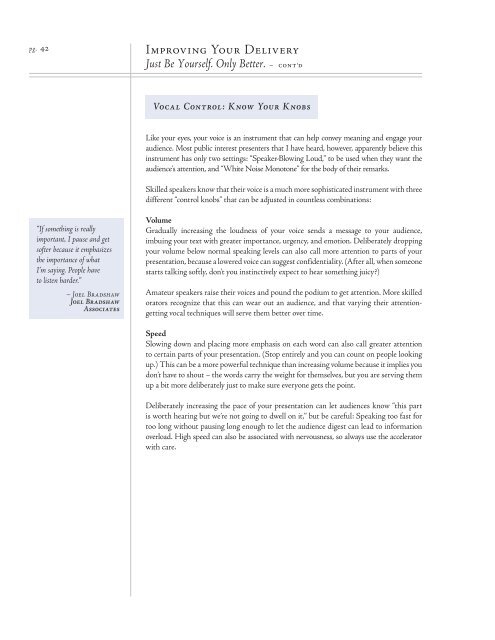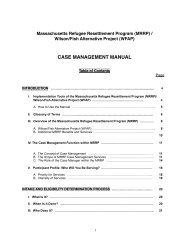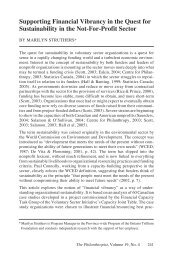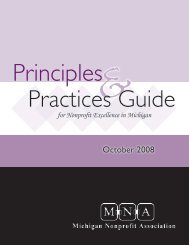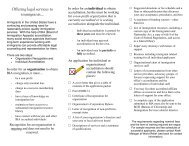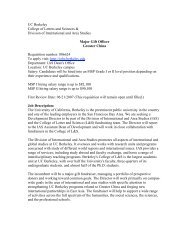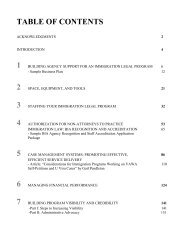Why Bad Presentations Happen to Good Causes - The Goodman ...
Why Bad Presentations Happen to Good Causes - The Goodman ...
Why Bad Presentations Happen to Good Causes - The Goodman ...
Create successful ePaper yourself
Turn your PDF publications into a flip-book with our unique Google optimized e-Paper software.
pg. 42<br />
“If something is really<br />
important, I pause and get<br />
softer because it emphasizes<br />
the importance of what<br />
I’m saying. People have<br />
<strong>to</strong> listen harder.”<br />
– Joel Bradshaw<br />
Joel Bradshaw<br />
Associates<br />
Improving Your Delivery<br />
Just Be Yourself. Only Better. – cont’d<br />
Vocal Control: Know Your Knobs<br />
Like your eyes, your voice is an instrument that can help convey meaning and engage your<br />
audience. Most public interest presenters that I have heard, however, apparently believe this<br />
instrument has only two settings: “Speaker-Blowing Loud,” <strong>to</strong> be used when they want the<br />
audience’s attention, and “White Noise Mono<strong>to</strong>ne” for the body of their remarks.<br />
Skilled speakers know that their voice is a much more sophisticated instrument with three<br />
different “control knobs” that can be adjusted in countless combinations:<br />
Volume<br />
Gradually increasing the loudness of your voice sends a message <strong>to</strong> your audience,<br />
imbuing your text with greater importance, urgency, and emotion. Deliberately dropping<br />
your volume below normal speaking levels can also call more attention <strong>to</strong> parts of your<br />
presentation, because a lowered voice can suggest confidentiality. (After all, when someone<br />
starts talking softly, don’t you instinctively expect <strong>to</strong> hear something juicy?)<br />
Amateur speakers raise their voices and pound the podium <strong>to</strong> get attention. More skilled<br />
ora<strong>to</strong>rs recognize that this can wear out an audience, and that varying their attentiongetting<br />
vocal techniques will serve them better over time.<br />
Speed<br />
Slowing down and placing more emphasis on each word can also call greater attention<br />
<strong>to</strong> certain parts of your presentation. (S<strong>to</strong>p entirely and you can count on people looking<br />
up.) This can be a more powerful technique than increasing volume because it implies you<br />
don’t have <strong>to</strong> shout – the words carry the weight for themselves, but you are serving them<br />
up a bit more deliberately just <strong>to</strong> make sure everyone gets the point.<br />
Deliberately increasing the pace of your presentation can let audiences know “this part<br />
is worth hearing but we’re not going <strong>to</strong> dwell on it,” but be careful: Speaking <strong>to</strong>o fast for<br />
<strong>to</strong>o long without pausing long enough <strong>to</strong> let the audience digest can lead <strong>to</strong> information<br />
overload. High speed can also be associated with nervousness, so always use the accelera<strong>to</strong>r<br />
with care.


